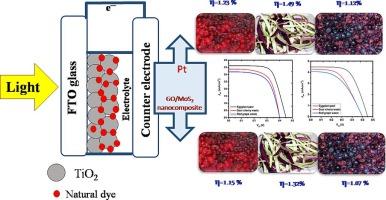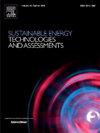Investigation of the use of food waste in renewable energy production: Extraction, fabrication and characterization of natural photosensitizers in DSSCs
IF 7.1
2区 工程技术
Q1 ENERGY & FUELS
Sustainable Energy Technologies and Assessments
Pub Date : 2024-11-07
DOI:10.1016/j.seta.2024.104066
引用次数: 0
Abstract
In this research, two important categories of environmental protection and green energy production have been studied. In this way, agricultural waste has been used to prepare photosensitizers in order to reduce the waste produced in the agricultural and food industry in addition to introducing sustainable materials for dye-sensitized solar cells (DSSCs). For this end, Eggplant peel, Sour cherry waste and Red grape waste, which are unavoidable sources of food industry, have been used to prepare natural sensitizer. Extraction was done in water and ethanol and used for FTIR, UV–Vis and CV analysis. The extracts had a bathochromic shift in ethanol compared to water. The CV test results showed that the extracts prepared in water and ethanol are suitable for use in the DSSCs. DSSCs was prepared using titanium dioxide as a semiconductor, extracts in water and ethanol, and platinum and GO/MoS2 nanocomposite in counter electrode. AM 1.5 light was chosen to study the photovoltaic performance and the prepared devices were evaluated. In this research, the effect of solvent and counter electrode on the DSSCs efficiency was investigated. The highest efficiency for the extract obtained from eggplant peel in ethanol and in the presence of platinum is about 1.49 %.

利用食物垃圾生产可再生能源的研究:提取、制造和表征 DSSC 中的天然光敏剂
在这项研究中,对环境保护和绿色能源生产这两个重要类别进行了研究。因此,除了为染料敏化太阳能电池(DSSC)引入可持续材料外,还利用农业废弃物制备光敏剂,以减少农业和食品工业产生的废弃物。为此,我们利用食品工业中不可避免的茄子皮、酸樱桃废料和红葡萄废料来制备天然敏化剂。萃取液在水和乙醇中进行,并用于傅立叶变换红外光谱、紫外可见光谱和紫外可见光谱分析。与水相比,提取物在乙醇中具有浴色偏移。CV 测试结果表明,在水和乙醇中制备的提取物适合用于 DSSC。以二氧化钛为半导体、水和乙醇中的提取物、铂和 GO/MoS2 纳米复合材料为对电极,制备了 DSSC。选择 AM 1.5 光源来研究光伏性能,并对制备的器件进行了评估。本研究考察了溶剂和对电极对 DSSC 效率的影响。茄子皮提取物在乙醇和铂存在下的最高效率约为 1.49%。
本文章由计算机程序翻译,如有差异,请以英文原文为准。
求助全文
约1分钟内获得全文
求助全文
来源期刊

Sustainable Energy Technologies and Assessments
Energy-Renewable Energy, Sustainability and the Environment
CiteScore
12.70
自引率
12.50%
发文量
1091
期刊介绍:
Encouraging a transition to a sustainable energy future is imperative for our world. Technologies that enable this shift in various sectors like transportation, heating, and power systems are of utmost importance. Sustainable Energy Technologies and Assessments welcomes papers focusing on a range of aspects and levels of technological advancements in energy generation and utilization. The aim is to reduce the negative environmental impact associated with energy production and consumption, spanning from laboratory experiments to real-world applications in the commercial sector.
 求助内容:
求助内容: 应助结果提醒方式:
应助结果提醒方式:


